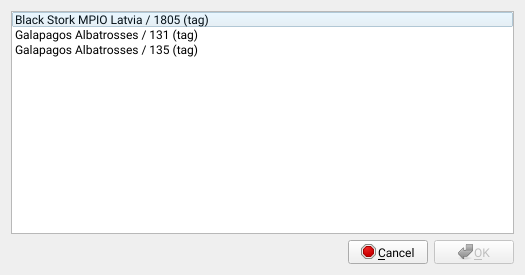Working with local data
Often, datasets persist on your local hard drive. Firetail supports a range of formats to be loaded via the file menu:

All datatypes (see below) are accessible via the File > Open CSV... menu.
If you encounter data that you expect to work with Firetail, do not hesitate
to contact our support support@firetail.de
When selecting datasets you may also select multiple files at once (shift select). These datasets will be opened in one viewport.
Overview of supported data
| Data Type | origin | contains | common extension | from FT Version |
|---|---|---|---|---|
| GPS | Movebank | lat/lon | -gps.txt | 1 |
| Reference Data | Movebank | categorial/numeric | -reference-data.csv | 4 |
| GPS | e-obs | lat/lon | -gps.txt | 1 |
| ACC | e-obs | bursts | -acc.txt | 1 |
| ECG | e-obs | - | -ecg.txt | 4 |
| Magnetic | e-obs | - | -mag.txt | 3 |
| Quaternion | e-obs | - | -quat.txt | 3 |
| GPS | Ornitela | lat/lon | via movebank | 5 |
| ACC | Ornitela | gps-coupled/plain | via movebank | 5 |
| GPS | Technosmart | lat/lon | .csv | 5 |
| ACC | Technosmart | gps-coupled/bursts | - | 5 |
| ACC Annotations | Firetail | tabular | annotations2.csv | 4 |
| GPS | Vectronics | lat/lon | -gps.csv | 5 (experimental) |
Burst type data
We learned that users are often confused by burst data types. We would like to clarify how burst recording works and how this affects the datasets you are working with.
Many high-res tags record sensor data at a fixed frequency starting at a given timestamp. We refer to this kind data as burst-type format. A burst is a in this regard a set of samples captured for a given amount of time.
This data has a fixed resolution e.g. 40Hz. This is usually much higher than the GPS frequency (1Hz and below). Burst data formats do not require a single line of data for each recorded value, in fact, copying the timestamp/individual id/… and other meta information more than 40-fold per second would result in highly redundant and large files (think of Movebank’s rich set of metadata).
Therefore burst-type formats capture all data each burst as a single entry (line). A header definition is required with at least the following fields to define each burst:
- start-timestamp: burst starts here
- acceleration-axes: one/two/three distinct characters (X, Y, Z) stating the the order of axes in the burst, usually X, XY or XYZ
- acceleration-frequency-per-axis: frequency in Hz
- accelerations-raw: consecutive singletons, 2-tuples or triplets (depending on acceleration axes)
The spacing of samples is uniquely given by the start timestamp and the axis frequency. To improve the overview when working with bursts, Firetail shows bursts consecutively without time gaps. The cursor will wait between non-consecutive bursts during replay.
E-OBS Datasets
Tags by e-obs offer state-of-the-art solutions to animal tracking. Data gathered from
these tags can be imported directly into Firetail using File > Open CSV Files.
E-obs and related modern tags feature a wide range of sensor data (see Event data) that Firetail can show fully synchronized.
Given data from an IMU (inertial measurement unit) is present, Firetail offers a visualization option to show the spatial orientation of the e-obs tracking device.
See also Acceleration Data.
Technosmart Datasets
Some of the most widespread Technosmart tags are supported for acceleration and GPS data:
- Axy-Trek
- Axy-5
Ornitela
We integrated support for Ornitela datasets and events. Ornitela users can actively monitor their Movebank data feeds from within Firetail and benefit from retrieving the latest data as an iterative update.
Loading Movebank CSV data
Movebank data can be imported directly via our API interface.
Loading local CSVs is possible via File > Open Movebank CSV File.
See also: Movebank data
Previous downloads
Data that has been downloaded previously via the Movebank data can be accessed directly.
- Open
File > Open Downloaded Data. - Choose a dataset, hit
OK
